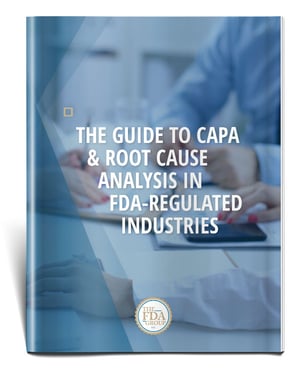Corrective and Preventive Action (CAPA) routinely tops the list of most-cited inspectional observations year after year, making it a clear target for investigators. When problems are found in your CAPA program, it can open your broader QMS up to intense scrutiny.
While many common CAPA problems are routinely reported on and somewhat easily detected, others can fly under the radar—silently growing into major compliance risks.
Let's take a moment to shed light on four upstream issues that can be hard to detect. Grab our free white paper for this, and much more on CAPA best practices and solutions to common problems: The Complete Guide to CAPA & Root Cause Analysis in FDA-Regulated Industries.
1. Drawing on the 8D Problem-Solving Model
While 8D is commonly used among quality engineers in the automotive industry, its import into the device world puts it at odds with regulatory demands both under FDA and ISO requirements.
In short, verification of effectiveness must be conducted after those actions are implemented. This is flipped in the traditional 8D model.
Read our full-write up of the issues of 8D and CAPA here.

"Your verification of effectiveness has to come after you have implemented corrective actions. This is a general problem. Many procedures treat verification as going back to make sure actions were implemented. Really what it's asking for is verification that corrective actions were effective.
Every one of your effectiveness checks is going to be different. If you've got a high-volume manufacturing situation where you're making tens of thousands of devices each week, you may be able to do an effectiveness check a week later.
However, others might require months before they've gathered enough data to conduct an effectiveness check. The 8D process flips verification—but even without the 8D process, it's easy to misunderstand what the effectiveness check is. It's imperative that this is done after data is collected and analyzed."
— Brian Dense
2. Setting Unreasonable Timeframes & Deadlines
Another less-than-apparent CAPA problem is a tendency to use short, arbitrary timeframes for completing activities in an effort to convey a sense of tight control.
While the logic here is simple—tight control looks compliant—timeframes set in a vacuum are a recipe for disaster when they can’t be met. In this case, a procedure that can’t be carried out as written can be even worse than not having a procedure in the first place. By design, it’s set up to fail.
Read Also: What The FDA Expects from Your CAPA Process
This problem is not exclusive to CAPA and neither is its solution. The following remedy can be applied when establishing or improving procedures just about anywhere within your quality system.
- Gather a team of stakeholders in the process who represent each function necessary to completing the work. This team should be just big enough to be genuinely representative, but not too large to make consensus difficult, slow, or impossible.
- Schedule a process discussion that lasts at least a few hours.
- Map it out. Draw a flowchart. What are the steps? What are the inputs? What are the outputs to each step in the process?
3. Feedback Loops
Sources of information are incredibly important in just about any procedure. Misaligned inputs almost always result in some amount of missing information. In CAPA, this can be a critical problem.
To ensure your inputs are aligned, identify the various processes that have worked for revealing root causes in the past. Discuss these matters with each of the stakeholders and write out a process in flow chart form.
With a flow chart in-hand, a procedure can be written or updated with verbiage, steps, and sections for responsibilities, purpose, scope, etc.
"In many areas, procedural steps are best written to match a flowchart created by a team who carefully mapped the process together.
The end result is a process that is easier to follow and often the most direct way to accomplish a task. I typically recommend starting with the process instead of the regulations and revising if needed. Don’t let the regulation tell you what the process is. Begin with the process, and then hang the requirements on top of that.”— Brian Dense
4. Politics
Problems caused by political dynamics within an organization can be particularly insidious and difficult to address, let alone solve.
While endless white papers could be written on the effects of ego, power, and personalities, detecting their influence on your CAPA program is often relatively simple: Are too many people touching it?
Read Also: An Informed Guide to Human Error in CAPA
Overcommitting staff in the approval process in particular can be a clear signal that problems may be getting swept under the rug—or conversely—that the program is being overused.
Politics are also usually at play when viable solutions get turned down for a myriad of reasons. In general, the remedy is having the right people—and right number of people—at each level. If one step feels bloated, it typically is.
In general, I suggest teams reduce the number of approvals that are required in the process, while ensuring those in charge of approval are making genuine decisions in the interest of the company. CAPA is one area where superfluous participation can easily lead to problems.”
— Brian Dense
The Value of Enlisting a Third Party Quality Systems Expert When Optimizing Your CAPA Process
While certain circumstances clearly underscore the need for outside expertise, the value of engaging a consultant, both financially and operationally, may not always be apparent for routine optimization and improvement projects.
To avoid wasted time and budget—and potentially serious quality and compliance problems that could otherwise be avoided with the help of an experienced consultant, we’ve summarized a few of the major ways companies realize the benefits of bringing in an expert.
- Answering complex regulatory questions and navigating new regulatory territory
- Preventing the costs of enforcement and its expensive aftermath
- Avoiding the practical challenges of hiring from a small talent pool
- Bringing industry best practices and standards to your processes, procedures, and systems
For many companies, seeking outside help from third party experts can provide overall greater value compared to doing all regulatory work internally. While a per-hour billing rates may initially appear high, the total financial picture can be one of cost savings when consultants are able to provide an ROI on overall efficiency versus the alternative.
As FDA-regulated manufacturers continue to compete for top talent in a globalized market while navigating a more complex regulatory environment, regulatory compliance and quality assurance consultants will continue to offer valuable pathways for planning and completing projects quickly, reliably, and cost-effectively.
"I’ve spent thirty years working in the industry and there’s nothing in medical device manufacturing quality systems I haven’t touched one way or another—most of it many times over. When it comes to the value of an effective, knowledgeable consultant, there’s real Fresh perspective, un-tainted by the, ‘we don’t do it that way here.’ Consultants come in from the outside and they’ve seen a million ways to do it.
They’re adaptable to help you develop a process that best fits that organization, rather than just something that’s been band-aided over the years and never really was made efficient. I’m overusing the word politics, but and they come in with no politics. The consultant has no ax to grind with any department. You don’t have any fighting between, or power struggles, between functions because the consultants coming in, and he just wants to give them the best answer.”— Brian Dense
The FDA Groups provide expert Quality Assurance consulting services to pharmaceutical, biotechnology, medical device, and biologic companies to help ensure they are in compliance with current business best practices and regulations.
Our team of auditors can perform a detailed assessment of your CAPA processes and any other existing quality systems and processes to highlight problem areas, recommend and optionally implement improvements to build quality systems that are appropriate for your company’s stage of development. We can assist you with all aspects of compliance, as they impact your product, including GLP, GMP, QSR, and GCP.
Contact us today to get the conversation started, or read our free white paper below for a comprehensive guide to current best practices and solutions to pressing problems in Corrective and Preventive Action (CAPA).

The Guide to CAPA & Root Cause Analysis in FDA-Regulated Industries
We’ve gathered insights from quality and compliance experts who have seen it all and fixed it all when it comes to CAPA and root cause analysis.

